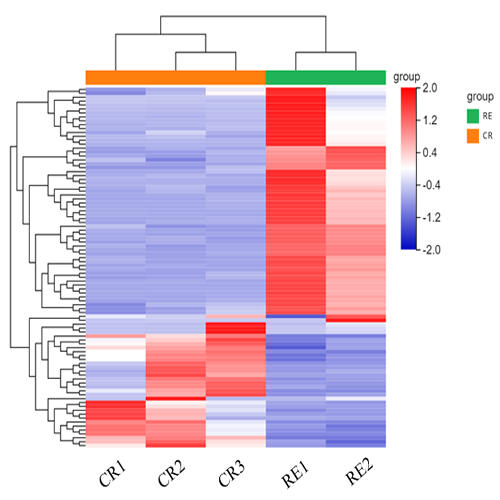
Contributions
Abstract: PB1803
Type: Publication Only
Session title: Stem cell transplantation - Experimental
Background
Relapse of the original disease is a major cause of death after allogeneic hematopoietic cell transplantation for acute myeloid leukemia (AML). It has been established that AML is driven by a subpopulation of rare cells with intrinsically defined stem cell properties. However, the mechanism of post-transplantation relapses at the stem cell level is not clear.
Aims
To describe role of microRNA (miRNA) in CD34+ hematopoietic stem/progenitor cells (HSPCs) from AML patients with relapse after allogeneic transplantation.
Methods
Bone marrow samples from 5 AML patients who received allogeneic hematopoietic cell transplantation, of which 2 patients relapsed after transplantation (RE) and 3 patients remained complete remission (CR). CD34+ HSPCs were sorted by CD34+ microbeads and analyzed by RNA-sequencing on an Illumina Hiseq 2500 platform to characterized all of miRNAs. Gene expression levels between groups of CD34+ HSPCs were compared with degeR to find out differential miRNAs. We performed the GO (Gene Ontology) and KEGG (Kyoto Encyclopedia of Genes and Genomes) enrichment analysis for the target gene candidates of differential miRNAs to predict the potential function of relapsed specific microRNAs. A value of P<0.05 (2-sided) was considered to be statistically significant.
Results
Compared with CR patients, we found that 61 miRNA were upregulated and 31 are significantly downregulated. The analysis showed the total of 92 miRNAs to be signifcantly altered as shown in the heatmap in Figure 1. The target gene candidates of differential miRNAs were enriched in numerous Go biological process including: immune system process, cell cycle, apoptotic process, protein transport, intracellular signal transduction, protein phosphorylation and so on . The top 10 signifcantly (P< 0.05) affected pathways identified by GO analysis.

Conclusion
The present study proved that miRNAs play an important role in AML patients with relapse after transplantation. The result may improved understanding of the special molecular alterations in relapse after transplantation and may provide potential targets for future clinical applications.
Keyword(s): Allogeneic hematopoietic stem cell transplant, Relapse
Abstract: PB1803
Type: Publication Only
Session title: Stem cell transplantation - Experimental
Background
Relapse of the original disease is a major cause of death after allogeneic hematopoietic cell transplantation for acute myeloid leukemia (AML). It has been established that AML is driven by a subpopulation of rare cells with intrinsically defined stem cell properties. However, the mechanism of post-transplantation relapses at the stem cell level is not clear.
Aims
To describe role of microRNA (miRNA) in CD34+ hematopoietic stem/progenitor cells (HSPCs) from AML patients with relapse after allogeneic transplantation.
Methods
Bone marrow samples from 5 AML patients who received allogeneic hematopoietic cell transplantation, of which 2 patients relapsed after transplantation (RE) and 3 patients remained complete remission (CR). CD34+ HSPCs were sorted by CD34+ microbeads and analyzed by RNA-sequencing on an Illumina Hiseq 2500 platform to characterized all of miRNAs. Gene expression levels between groups of CD34+ HSPCs were compared with degeR to find out differential miRNAs. We performed the GO (Gene Ontology) and KEGG (Kyoto Encyclopedia of Genes and Genomes) enrichment analysis for the target gene candidates of differential miRNAs to predict the potential function of relapsed specific microRNAs. A value of P<0.05 (2-sided) was considered to be statistically significant.
Results
Compared with CR patients, we found that 61 miRNA were upregulated and 31 are significantly downregulated. The analysis showed the total of 92 miRNAs to be signifcantly altered as shown in the heatmap in Figure 1. The target gene candidates of differential miRNAs were enriched in numerous Go biological process including: immune system process, cell cycle, apoptotic process, protein transport, intracellular signal transduction, protein phosphorylation and so on . The top 10 signifcantly (P< 0.05) affected pathways identified by GO analysis.

Conclusion
The present study proved that miRNAs play an important role in AML patients with relapse after transplantation. The result may improved understanding of the special molecular alterations in relapse after transplantation and may provide potential targets for future clinical applications.
Keyword(s): Allogeneic hematopoietic stem cell transplant, Relapse


